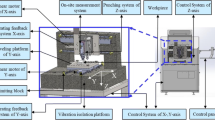Abstract
We propose a process technology that can be applied to a variety of applications by machining existing lenses to create an optical system required for research by modifying commercial glass optical systems. A 1-in. hole was created in an LF5 glass lens by drilling, followed by spiral grinding, and finally, precision spiral grinding. In addition, cracking and chipping were analyzed according to the processing process and optimized process conditions. We fabricated an achromatic doublet lens with a diameter of 50.8 mm, focal fa of 75 mm and fba of 65.7 mm, under optimized processing conditions. The processed lenses were determined by measuring the surface geometry of the lenses using ASI, and the lenses were inspected internally using OCT and dark field measurements to verify the internal sectional cracks and chipping of the lenses. The results confirm that there are no problems with the use of the hole in the existing glass lens as an optics. In addition, the manufactured lens will be available as an integrated optical system that can combine lenses with mirrors or detectors to create small systems and multi-axial views.










Similar content being viewed by others
References
Huerta, M., & Malkin, S. (1976). Grinding of glass: The mechanics of the process. Journal of Engineering for Industry, 98(2), 459–467.
Tianbiao, Y., Haonan, L., & Wanshan, W. (2016). Experimental investigation on grinding characteristics of optical glass BK7: With special emphasis on the effects of machining parameters. The International Journal of Advanced Manufacturing Technology, 82(5–8), 1405–1419.
Li, H., Yu, T., Zhu, L., & Wang, W. (2016). Evaluation of grinding-induced subsurface damage in optical glass BK7. Journal of Materials Processing Technology, 229(1), 785–794.
Kim, J., Kong, J., & Chung, K. (2013). Analysis of annealing processes of glass sheets based on structural relaxation model. International Journal of Mechanical Sciences, 66, 249–259.
Ma, L. J., Gong, Y. D., Chen, X. H., Duan, T. Y., & Yang, X. Y. (2014). Surface roughness model in experiment of grinding engineering glass-ceramics. Proceedings of the Institution of Mechanical Engineers, Part B: Journal of Engineering Manufacture, 228(12), 1563–1569.
Kumar, A. S., Lim, H. S., Rahman, M., & Fathima, K. (2002). A study on the grinding of glass using electrolytic in-process dressing. Journal of Electronic Materials, 31(10), 1039–1046.
Zhong, Z., & Lee, W. Y. (2001). Grinding of silicon and glass using a new dressing device and an improved coolant system. Journal of Materials and Manufacturing Processes, 16(4), 471–482.
Sayuti, M., Sarhan, A., Diaa, A. A., Shukor, B. A., & Hamdi, M. (2011). Optimizing the machining parameters in glass grinding operation on the CNC milling machine for best surface roughness. Advanced Materials Research, 154–155, 721–726.
Hošek, J., & Studenovský, K. (2013). Reducing the edge chipping for capillary end face grinding and polishing. EPJ Web of Conferences, 48, 00005.
Chen, B., Li, S., Deng, Z., Guo, B., & Zhao, Q. (2017). Grinding marks on ultra-precision grinding spherical and aspheric surfaces. International Journal of Precision Engineering and Manufacturing-Green Technology, 4(4), 419–429.
Nam, J., & Lee, S. W. (2018). Machinability of titanium alloy (Ti–6Al–4V) in environmentally–friendly micro-drilling process with nanofluid minimum quantity lubrication using nanodiamond particles. International Journal of Precision Engineering and Manufacturing-Green Technology, 5(1), 29–35.
Acknowledgements
This research was supported by Creative Convergence Research Project (CAP-PN2017003) funded by the National Research Council of Science and Technology (NST) and Korea Basic Science Institute Grant (D38615).
Author information
Authors and Affiliations
Corresponding authors
Additional information
Publisher's Note
Springer Nature remains neutral with regard to jurisdictional claims in published maps and institutional affiliations.
Rights and permissions
About this article
Cite this article
Je, S., Yeo, I., Jung, Sk. et al. Development of Spiral Grinding Process Technology for Glass Lens Hole Machining. Int. J. Precis. Eng. Manuf. 20, 1877–1883 (2019). https://doi.org/10.1007/s12541-019-00197-8
Received:
Revised:
Accepted:
Published:
Issue Date:
DOI: https://doi.org/10.1007/s12541-019-00197-8




